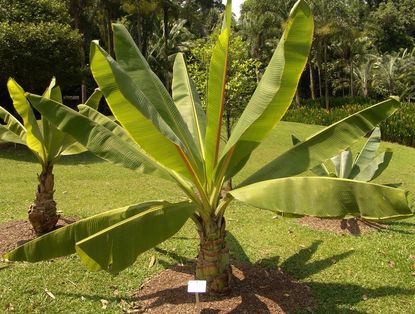What Is False Banana: Information About Ensete False Banana Plants


Known by a multitude of names depending on where it's cultivated, Ensete false banana plants are an important food crop in many parts of Africa. Ensete ventricosum cultivation can be found in the countries of Ethiopia, Malawi, throughout South Africa, Kenya, and Zimbabwe. Let's learn more about false banana plants.
What is False Banana?
A valuable food crop, Ensete ventricosum cultivation provides more food per square meter than any other cereal. Known as “false banana,” Ensete false banana plants look just like their namesakes, only larger-- 39 feet (12 m.) high, with leaves that are more erect, and inedible fruit. The large leaves are lance-shaped, arrayed in a spiral, and are bright green struck with a red midrib. The “trunk” of Ensete false banana plant is really three separate sections. So what is false banana used for? Inside this meter-thick trunk or “pseudo-stem” lays the main product of starchy pith, which is pulped and then fermented while buried underground for three to six months. The resulting product is called “kocho,” which is a bit like heavy bread and is eaten with milk, cheese, cabbage, meat, and/or coffee. The resultant Ensete false banana plants provide not only food, but fiber for making ropes and mats. False banana also has medicinal uses in the healing of wounds and bone breaks, enabling them to heal more quickly.
Additional Information About False Banana
This traditional staple crop is highly drought resistant, and in fact, can live up to seven years without water. This provides a reliable food source for the people and ensures no famine period during the drought. Ensete takes four to five years to reach maturation, therefore, plantings are staggered to maintain an available harvest for each season. While wild Ensete is produced from seed propagation, Ensete ventricosum cultivation occurs from suckers, with up to 400 suckers produced from one mother plant. These plants are cultivated in a mixed system interspersing grains like wheat and barley or sorghum, coffee, and animals with the Ensete ventricosum cultivation.
Ensete's Role in Sustainable Farming
Ensete acts as a host plant to such crops as coffee. Coffee plants are planted in Ensete's shade and are nurtured by the vast water reservoir of its fibrous torso. This makes for a symbiotic relationship; a win/win for the farmer of a food crop and cash crop in a sustainable manner. Although a traditional food plant in many parts of Africa, not every culture there cultivates it. Its introduction into more of these areas is extremely important and may be the key to nutritional security, engender rural development, and support sustainable land use. As a transitional crop replacing such environmentally damaging species as Eucalyptus, the Ensete plant is seen as a great boon. Proper nutrition is necessary and has been shown to foster higher levels of education, health of course, and general prosperity.
Gardening tips, videos, info and more delivered right to your inbox!
Sign up for the Gardening Know How newsletter today and receive a free download of our most popular eBook "How to Grow Delicious Tomatoes."

Amy Grant has been gardening for 30 years and writing for 15. A professional chef and caterer, Amy's area of expertise is culinary gardening.
-
 10 Best Apartment Plants To Turn Your Small Space Into An Oasis
10 Best Apartment Plants To Turn Your Small Space Into An OasisThe best apartment plants can lend an ambience of the tropics, brighten up a space, or add a touch of drama, and turn an apartment into a relaxing oasis.
By Amy Grant
-
 Grow a Bathroom Oasis: 8 Best Bathroom Plants With No Light or Low Light
Grow a Bathroom Oasis: 8 Best Bathroom Plants With No Light or Low LightSome apartment dwellers grow the best bathroom plants with no light or low light. Read how one of our favorite plant lovers does it in the big city.
By Teo Spengler